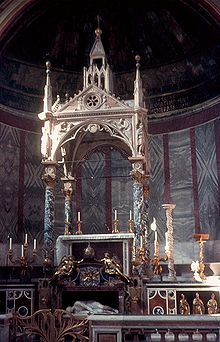
Back طقس روماني Arabic طقس رومانى ARZ Рымскі абрад Byelorussian Ritu romà Catalan Římský ritus Czech Römischer Ritus German Roma rito Esperanto Rito romano Spanish Erromatar erritu Basque آیین رومی Persian
Part of a series on |
| Roman Rite Mass of the Catholic Church |
|---|
 |
| A. Introductory rites |
|
| B. Liturgy of the Word |
| C. Liturgy of the Eucharist |
|
| D. Concluding rites |
| Ite, missa est |
|
|

The Roman Rite (Latin: Rītus Rōmānus)[1] is the most common ritual family for performing the ecclesiastical services of the Latin Church, the largest of the sui iuris particular churches that comprise the Catholic Church. The Roman Rite governs rites such as the Roman Mass and the Liturgy of the Hours as well as the manner in which sacraments and blessings are performed.[2]
The Roman Rite developed in the Latin language in the city of Rome and, while distinct Latin liturgical rites such as the Ambrosian Rite remain, the Roman Rite has gradually been adopted almost everywhere in the Latin Church. In medieval times there were numerous local variants, even if all of them did not amount to distinct rites, yet uniformity increased as a result of the invention of printing and in obedience to the decrees of the Council of Trent of 1545–1563 (see Quo primum). Several Latin liturgical rites that survived into the 20th century were abandoned after the Second Vatican Council. The Roman Rite is now the most widespread liturgical rite not only in the Catholic Church but in Christianity as a whole.
The Roman Rite has been adapted through the centuries and the history of its Eucharistic liturgy can be divided into three stages: the Pre-Tridentine Mass, Tridentine Mass, and Mass of Paul VI. It is now normally celebrated in the form promulgated by Pope Paul VI in 1969 and revised by Pope John Paul II in 2002, but use of the Roman Missal of 1962 remains authorized under the conditions indicated in the 2021 papal document Traditionis Custodes.
- ^ Lott, J. Bert (2012-08-30). Death and Dynasty in Early Imperial Rome: Key Sources, with Text, Translation, and Commentary. Cambridge University Press. ISBN 9781139560306.
- ^ Catholic University of America (1967). New Catholic Encyclopedia. Vol. 12 (1 ed.). McGraw-Hill. p. 612. ISBN 9780070102354. Retrieved 26 December 2022 – via Internet Archive.